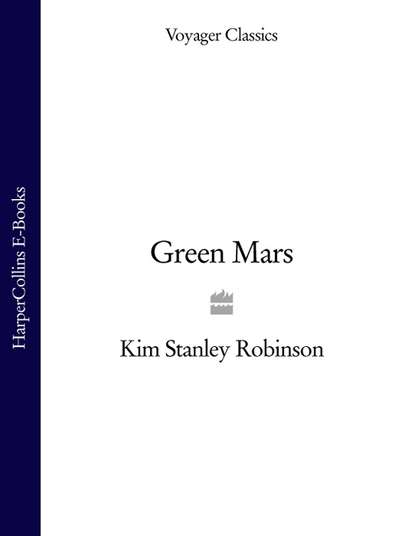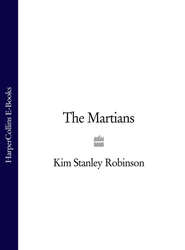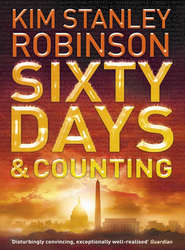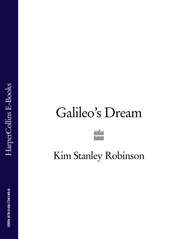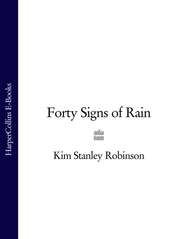По всем вопросам обращайтесь на: info@litportal.ru
(©) 2003-2024.
✖
Green Mars
Автор
Год написания книги
2018
Настройки чтения
Размер шрифта
Высота строк
Поля
Flight time, however, was only three months. So Art settled down and watched TV, concentrating on documentaries about Mars. He ate in the dining room, which was decorated to look like one of the great ocean liners of the 1920s, and he gambled a bit in the casino, which was decorated to look like one of the Las Vegas casinos of the 1970s. But mostly he slept and watched TV, the two activities melting into each other so that he dreamed very lucidly about Mars, while the documentaries took on a very surreal logic. He saw the famous videotapes of the Russell–Clayborne debate, and that night dreamed he was unsuccessfully arguing with Ann Clayborne, who, just as in the vids, looked like the farmer’s wife in “American Gothic” only more gaunt and severe. Another film, taken by a flying drone, also affected him deeply; the drone had dropped off the side of one of the big Marineris cliffs, and fallen for nearly a minute before pulling out and swooping low over the jumbled rock and ice on the canyon floor. Repeatedly in the following weeks Art dreamed of making that fall himself, and woke up just before impact. It appeared that parts of his unconscious mind felt that the decision to go had been a mistake. He shrugged at this, ate his meals, and practised his walking. He was biding his time. Mistake or not, he was committed.
Fort had given him an encryption system, and instructions to report back on a regular basis, but in transit he found there was very little to say. Dutifully he sent off a monthly report, each one the same: We’re on our way. All seems well. There was never any reply.
And then Mars swelled up like an orange thrown at the TV screens, and soon after that they were there, crushed into their g couches by an extremely violent aerobraking, and then crushed again in their ferry’s chairs; but Art came through these flattening decelerations like a veteran, and after a week in orbit, still rotating, they docked with New Clarke. New Clarke proved to have only a very small gravity, which barely held people to the floor, and made Mars appear to be overhead. Art’s space sickness returned. And he had a two-day wait before his reservation for an elevator ride.
The elevator cars proved to be like slender tall hotels, and they ran their tightly packed human cargo down toward the planet over a period of five days, with no gravity to speak of until the last couple of days, when it got stronger and stronger, until the elevator car slowed and descended gently into the receiving facility called the Socket, just west of Sheffield on Pavonis Mons, and the g came to something like the g in the Ganesh’s g ring. But a week of space sickness had left Art completely devastated, and as the elevator car opened, and they were guided out into something very like an airport terminal, he found himself scarcely able to walk, and amazed at how much nausea decreased one’s desire to live. It was four months to the day since he had got the fax from William Fort.
The trip from the Socket into Sheffield proper was by subway, but Art would have been too miserable to notice a view even if there had been one. Wasted and unsteady, he tip-toed bouncily down a tall hallway after someone from Praxis, and collapsed thankfully on a bed in a small room. Martian g felt blessedly solid when he was lying down, and after a while he fell asleep.
When he woke he could not remember where he was. He looked around the little room, completely disoriented, wondering where Sharon had gone and why their bedroom had got so small. Then it came back. He was on Mars.
He groaned, and sat up. He felt hot and yet detached from his body, and everything was pulsing slightly, though the room lights appeared to be functioning normally. There were curtains covering the wall opposite the door, and he stood and walked over, and opened them with a single pull.
“Hey!” he cried, leaping back. He woke up a second time, or so it felt.
It was like the view out an aeroplane window. Endless open space, and a bruise-coloured sky above, the sun like a blob of lava; and there far below stretched a flat rocky plain—flat and round, as it lay at the bottom of an enormous circular cliff—extremely circular—remarkably circular, in fact, for a natural feature. It was difficult to estimate how distant the far side of the cliff was. Features of the cliff were perfectly clear, but structures on the opposite rim were teensy; what looked like an observatory could have fit on a pinhead.
This, he concluded, was the caldera of Pavonis Mons. They had landed at Sheffield, so really there could be no doubt about it. Therefore it was some sixty kilometres across the circle to that observatory, as Art recalled from his video documentaries, and five kilometres to the floor. And all of it completely empty, rocky, untouched, primordial—the volcanic rock as bare as if cooled the week before—nothing at all of humanity in it—no sign of terraforming. It must have looked exactly like this to John Boone, a half century before. And so … alien. And big. Art had looked into the calderas of Etna and Vesuvius, while on vacation from Tehran, and those two craters were big by Terran standards, but you could have lost a thousand of them in this, this thing, this hole …
He closed the curtains and slowly got dressed, his mouth imitating the shape of the unearthly caldera.
A friendly Praxis guide named Adrienne, tall enough to be a Martian native but possessing a strong Australian accent, collected him and took him and half a dozen other new arrivals on a tour of the town. Their rooms turned out to be on the city’s lowest level, though it wouldn’t be lowest for long: Sheffield was in the process of burrowing downward these days, to give as many rooms as possible the view onto the caldera that had so disconcerted Art.
An elevator took them up nearly fifty storeys, and let them out in the lobby of a shiny new office building. They walked out its big revolving doors and emerged on a wide grassy boulevard, and walked down it past squat buildings faced with polished stone and big windows, separated by narrow grassy side streets, and a great number of construction sites, as many buildings were still in various stages of completion. It was going to be a handsome town, the buildings mostly three and four storeys tall, getting taller as they moved south, away from the caldera rim. The green streets were crowded with people, and the occasional small tram running on narrow tracks set in the grass; there was a general air of bustle and excitement, caused no doubt by the arrival of the new elevator. A boom town.
The first place Adrienne took them was across a boulevard to the caldera rim. She led the seven newcomers out into a thin curving park, to the nearly invisible tenting that encased the town. The transparent fabrics were held in place by equally transparent geodesic struts, anchored in a chest-high perimeter wall. “The tenting has to be stronger than usual up here on Pavonis,” Adrienne told them, “because the atmosphere outside is still extremely thin. It’ll always be thinner than the lowlands, by a factor of ten.”
She led them out into a viewing blister in the tent wall, and looking down between their feet they could see through the blister’s transparent deck, straight down onto the caldera floor some five kilometres below them. People exclaimed in delicious fright, and Art bounced on the clear floor uneasily. The width of the caldera was coming into perspective for him; the north rim was just about as far away as Mt Tamalpais and the Napa hills when one descended into the San Jose airport. That was no extraordinary distance. But the depth below, now, the depth; over five kilometres, or about twenty thousand feet. “Quite a hole!” Adrienne said.
Mounted telescopes and display plaques with map drawings enabled them to spot the section of the previous version of Sheffield, now lying on the caldera floor. Art had been wrong about the caldera’s untouched primeval nature; an insignificant pile of cliff-bottom talus, with some shiny dots in it, was in fact the ruins of the original city.
Adrienne described with great gusto the destruction of the town in 2061. The falling elevator cable had, of course, crushed the suburbs east of its socket in the very first moments of the fall. But then the cable had wrapped all the way around the planet, delivering a massive second blow to the south side of town, a blow which had caused an undiscovered fault in the basalt rim to give way. About a third of the town had been on the wrong side of this fault, and had fallen the five kilometres to the caldera floor. The remaining two-thirds of the town had been knocked flat. Luckily the occupants had mostly evacuated in the four hours between the detachment of Clarke and the second coming of the cable, so loss of life had been minimised. But Sheffield had been utterly destroyed.
For many years after that, Adrienne told them, the site had lain abandoned, a wreck like so many other towns after the unrest of ’61. Most of those other towns had been left in ruins, but Sheffield’s location remained the ideal place for tethering a space elevator, and when Subarashii began organising the in-space construction of a new one in the late 2080s, construction on the ground had rapidly followed. A detailed areological investigation had found no other faults in the southern rim, which had justified rebuilding right on the edge, on the same site as before. Demolition vehicles had cleared the wreckage of the old town, shoving most of it over the rim, and leaving only the easternmost section of town, around the old socket, as a kind of monument to the disaster—also as the central element of a little tourist industry, which had clearly been an important part of the town’s income in the fallow years before an elevator had been reinstalled.
Adrienne’s next point on the tour led them out to see this preserved bit of history. They took a tram to a gate in the east wall of the tent, and then walked through a clear tube into a smaller tent, which covered the blasted ruins, the concrete mass of the old cable facility, and the lower end of the fallen cable. They walked a roped path that had been cleared of wreckage, staring curiously at the blasted ruins, the foundations and twisted pipes. It looked like the results of saturation bombing.
They came to a halt under the butt end of the cable, and Art observed it with professional interest. The big cylinder of black carbon filaments looked nearly undamaged by the fall, although admittedly this was the part that had hit Mars with the least force. The end had jammed down into the Socket’s big concrete bunker, Adrienne said, then been dragged a couple of kilometres as the cable had fallen down the eastern slope of Pavonis. That wasn’t that much of a beating for material designed to withstand the pull of an asteroid swinging beyond the areosynchronous point.
And so it lay there, as if waiting to be straightened up and put back in place: cylindrical, three storeys high, its black bulk encrusted by steel tracks and collars and the like. The tent only covered a hundred metres or so of it; after that it ran on uncovered, east along the wide rounded plateau of the rim, until it disappeared over the rim’s outer edge, which formed their horizon—they could see nothing of the planet below. But out away from the town they could see better than ever that Pavonis Mons was huge—its rim alone was an impressive expanse, a doughnut of flat land perhaps thirty kilometres wide, from the abrupt inner edge of the caldera to the more gradual drop-off down the volcano’s flanks. Nothing of the rest of Mars could be seen from their vantage point, so it seemed they stood on a high circular ring world, under a dark lavender sky.
Just to the south of them, the new Socket was like a titanic concrete bunker, the new elevator cable rising out of it like an elevator cable, standing alone as if in some version of the Indian rope trick, thin and black and straight as a plumb line dropping down from heaven—visible for only a couple of tall skyscrapers’ worth of height, at most—and, given the wreckage they stood in, and the immensity of the volcano’s bare rocky peak, as fragile-looking as if it were a single carbon nanotube filament, rather than a bundle of billions of them, and the strongest structure ever made. “This is weird,” Art said, feeling hollow and unsettled.
After their tour of the ruins, Adrienne took them back to a plaza café in the middle of the new town, where they had lunch. Here they could have been in the heart of a fashionable district in any town anywhere—it could have been Houston or Tblisi or Ottawa, in some neighbourhood where a lot of noisy construction marked a fresh prosperity. When they went back to their rooms, the subway system was likewise familiar to the eye—and when they got out, the halls of the Praxis floors were those of a fine hotel. All utterly familiar—so much so that it was again a shock to walk into his room and look out the window and see the awesome sight of the caldera—the bare fact of Mars, immense and stony, seeming to exert a kind of vacuum pull on him through the window. And in fact if the window pane were to break the pressure blowout would certainly suck him immediately into that space; an unlikely eventuality, but the image still gave him an unpleasant thrill. He closed the curtains.
And after that he kept the curtains closed, and tended to stay on the side of his room away from the window. In the mornings he dressed and left the room quickly, and attended orientation meetings run by Adrienne, which were joined by a score or so of new arrivals. After lunching with some of them, he spent his afternoons touring the town, working earnestly on his walking skills. One night he thought to send a coded report off to Fort: On Mars, going through orientation. Sheffield is a nice town. My room has a view. There was no reply.
Adrienne’s orientation took them to a number of Praxis buildings, both in Sheffield and up the east rim, to meet people in the transnational’s Martian operations. Praxis had much more of a presence on Mars than it did in America. During Art’s afternoon walks he tried to gauge the relative strengths of the transnationals, just by the little plates on the sides of the buildings. All the biggest transnats were there—Armscor, Subarashii, Oroco, Mitsubishi, The Seven Swedes, Shellalco, Gentine, and so on—each occupying a complex of buildings, or even entire neighbourhoods of the town. Clearly they were all there because of the new elevator, which had made Sheffield once again the most important city on the planet. They were pouring money into the town, building submartian subdivisions, and even entire tent suburbs. The sheer wealth of the transnats was obvious in all the construction—and also, Art thought, in the way people moved—there were a lot of people bouncing around the streets just as clumsily as he was, newcomer businessmen or mining engineers or the like, concentrating with furrowed brow on the act of walking. It was no great trick to pick out the tall young natives, with their catlike co-ordination; but they were in a distinct minority in Sheffield, and Art wondered if that were true everywhere on Mars.
As for architecture, space under the tent was at a premium, and so the completed buildings were bulky, often cubical, occupying their lots right out to the street and right up to the tent. When all the construction was finished there would only be a network of ten triangular plazas, and the wide boulevards, and the curving park along the rim, to keep the town from being a continuous mass of squat skyscrapers, faces with polished stone of various shades of red. It was a city built for business.
And it looked to Art like Praxis was going to get a good share of that business. Subarashii was the general contractor for the elevator, but Praxis was supplying the software as they had for the first elevator, and also some of the cars, and part of the security system. All these allocations, he learned, had been made by a committee called the United Nations Transitional Authority, supposedly part of the UN, but controlled by the transnats; and Praxis had been as aggressive on this committee as any of the others. William Fort may have been interested in bio-infrastructure, but the ordinary kind was obviously not outside Praxis’s field of operations; there were Praxis divisions building water supply systems, train pistes, canyon towns, wind power generators, and areothermal plants. The latter two were widely regarded as marginal endeavours, as the new orbiting solar collectors and a fusion plant in Xanthe were turning out so well, not to mention the older generation of integral fast reactors; but local energy sources were the speciality of the Praxis subsidiary Power From Below, and so that was what they did, working hard in the outback.
Praxis’s local salvage subsidiary, the Martian equivalent of Dumpmines, was called Ouroborous, and like Power From Below it was also fairly small. In truth, as the Ouroborous people were quick to tell Art when they met one morning, there was not a large rubbish output on Mars; almost everything was recycled or put to use in creating agricultural soil, so each settlement’s dump was really more of a holding facility for miscellaneous materials, awaiting their particular use. Ouroborous therefore got its business by finding and collecting the garbage or sewage that was somehow recalcitrant—toxic, or orphaned, or simply inconvenient—and then finding ways to turn it to use.
The Ouroborous team in Sheffield occupied one floor of Praxis’s downtown skyscraper. The company had got its start excavating the ruins of the old town, before the ruins had been so unceremoniously shoved over the side. A man named Zafir headed the fallen cable salvage project, and he and Adrienne accompanied Art to the train station, where they got on a local train and took a short ride around to the east rim, to a line of suburb tents. One of the tents was the Ouroborous storage facility, and just outside it, among many other vehicles, was a truly gigantic mobile processing factory, called the Beast. The Beast made a SuperRathje look like a compact car—it was a building rather than a vehicle, and almost entirely robotic. Another Beast was already out processing the cable in west Tharsis, and Art was slated to go out and make an onsite inspection of it. So Zafir and a couple of technicians showed him around the inside of the training vehicle, ending up in a wide compartment on the top floor, where there were living quarters for any humans that might be visiting.
Zafir was enthusiastic about what the Beast out on west Tharsis had found. “Of course just recovering the carbon filament and the diamond gel helixes gives us a basic income stream,” he said. “And we are doing well with some brecciated exotics metamorphosed in the final hemisphere of the fall. But what you’ll be interested in are the buckyballs and buckytubes. Temperatures and pressures in the west Tharsis zone turned out to be similar to those used in the arc-reactor-synthesis method of making fullerenes, and so there is a hundred-kilometre stretch out there where carbon on the bottom side of the cable consists of buckyballs—mostly sixties, but also some thirties, and a variety of superbuckies and buckytubes of all lengths.” And some of the superbuckies had formed with other elements trapped inside their carbon cage. These full fullerenes were useful in composite manufacturing, but very expensive to make in the lab because of the high amounts of energy required. So they were a nice find. “And it’s sorting out the various superbuckies where your ion chromatography will come in.”
“So I understand,” Art said. He had done work with ion chromatography during analyses in Georgia, and this was his ostensible reason for being sent into the outback. So over the next few days Zafir and some Beast technicians trained Art in dealing with the Beast, and after these sessions they had dinner together at a small restaurant in the suburb tent on the east rim. After sunset they had a great view of Sheffield, some thirty kilometres around the curve of the rim, glowing in the twilight like a lamp perched on the black abyss.
As they ate and drank, the conversation seldom turned to the matter of Art’s project, and considering it, Art decided that this was probably a deliberate courtesy on his colleagues’ part. The Beast was fully self-operating, and though there were some problems to be solved in sorting out the recently discovered full fullerenes, there must have been local ion chromatographers who could have done the job. So there was no obvious reason why Praxis should have sent Art up from Earth to do it, and there had to be something more to his story. And so the group avoided the topic, saving Art the embarrassment of lies, or awkward shrugs, or an explicit appeal to confidentiality.
Art would have been uncomfortable with any of these dodges, and so he appreciated their tact. But it put a certain distance in their conversations. And he seldom saw the other Praxis newcomers, outside of orientation meetings; and he didn’t know anyone else in town, or elsewhere on the planet. So he was a little lonely, and the days passed in an increasing sense of uneasiness, even oppression. He kept the curtains closed on his window view, and ate in restaurants away from the rim. It began to feel a bit too much like the weeks on the Ganesh, which he now understood to have been a miserable time. Sometimes he had to fend off the feeling that it had been a mistake to come.
And so after their last orientation lecture, at a reception luncheon in the Praxis building, he drank more than was his custom, and took a few inhalations from a tall canister of nitrous oxide. Inhalation of recreational drugs was a local custom, apparently fairly big among Martian construction workers, he had been told, and there were even little canisters of various gases for sale from dispensers in some public men’s rooms. Certainly the nitrous added a certain extra bubbly quality to the champagne; it was a nice combination, like peanuts and beer, or ice cream and apple pie.
Afterward he walked down the streets of Sheffield bouncing erratically, feeling the nitrous champagne as a kind of anti-gravitational effect, which, added to the Martian baseline, made him feel altogether too light. Technically he weighed about forty kilos, but as he walked along it felt more like five. Very strange, even unpleasant. Like walking on buttered glass.
He nearly ran into a young man, slightly taller than him—a black-haired youth, as slender as a bird and as graceful, who quickly veered away from him and then steadied him with a hand to his shoulder, all in one smooth flow of movement.
The youth looked him in the eye. “Are you Arthur Randolph?”
“Yes,” Art said, surprised. “I am. And who are you?”
“I’m the one who contacted William Fort,” the young man said.
Art stopped abruptly, swaying to get back over his feet. The young man held him upright with a gentle pressure, his hand hot on Art’s upper arm. He regarded Art with a direct look, a friendly smile. Perhaps twenty-five, Art judged, perhaps younger—a handsome youth with brown skin and thick black eyebrows, and eyes that were slightly Asian, set wide over prominent cheekbones. An intelligent look, full of curiosity and a kind of magnetic quality, hard to pin down.
Art took to him instantly, for no reason he could tell. It was just a feeling. “Call me Art,” he said.
“And I am Nirgal,” the youth said. “Let’s go down to Overlook Park.”
So Art walked with him down the grassy boulevard to the park on the rim. There they strolled the path next to the coping wall, Nirgal helping Art with his drunken turns by frankly seizing his upper arm and steering him. His grasp had an electric penetrating quality to it, and was really very warm, as if the youth had a fever, though there was no sign of it in his dark eyes.
“Why are you here?” he asked—and his voice, and the look on his face, made the question into something other than a superficial enquiry. Art checked his response, thought about it.
“To help,” he said.
“So you will join us?”
Again the youth somehow made it clear that he meant something different, something fundamental.
And Art said, “Yes. Any time you like.”
Nirgal smiled, a quick delighted grin that he only partly overmastered before he said, “Good. Very good. But look, I’m doing this on my own. Do you understand? There are people who wouldn’t approve. So I want to slip you in among us, as if it were an accident. That’s okay with you?”
“That’s fine.” Art shook his head, confused. “That’s how I was planning on doing it anyway.”





